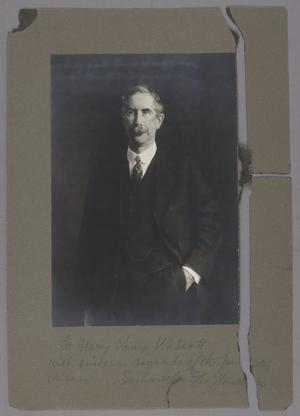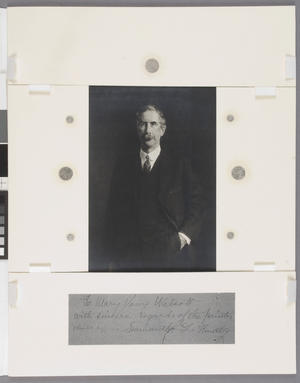Among the photographic records (Record Unit 95 - Photographic Collection, 1850s- ) at the Smithsonian Institution Archives is a portrait of Charles Greeley Abbot, an American astrophysicist and the fifth secretary of the Smithsonian. The portrait is a photograph of a painting of Abbot, which in turn was painted in reference to an even earlier photograph of Abbot. The photograph is mounted onto a gray board and beneath it is a penciled inscription from the painter – Samantha G. Huntly – dedicating it to Mary Vaux Walcott, the wife of Charles Doolittle Walcott who was the fourth secretary of the Smithsonian.
 At some point in the past the board broke in two places, creating a larger piece containing the photograph and two smaller pieces. Fortunately, the photograph itself survives in stable condition. Sometimes a conservator may consider unmounting the photograph, separating it from the broken board which is no longer offering it the physical support it needs. However, in this case the break runs through the artist's inscription. Separating the photographic portrait of Abbot from the inscription could potentially disassociate it with the inscription, which is what makes it a special and unique object.
At some point in the past the board broke in two places, creating a larger piece containing the photograph and two smaller pieces. Fortunately, the photograph itself survives in stable condition. Sometimes a conservator may consider unmounting the photograph, separating it from the broken board which is no longer offering it the physical support it needs. However, in this case the break runs through the artist's inscription. Separating the photographic portrait of Abbot from the inscription could potentially disassociate it with the inscription, which is what makes it a special and unique object.
All conservation treatments carry various levels of risk. Ultimately it was decided that unmounting the photograph and the facing paper, the frontmost layer of board, with the inscription on it was both a risky and time-consuming treatment in which the benefits did not necessarily outweight the risks at the time. Instead, I decided to create a new housing for the print that would hold it securely to help ensure that no further damage is inflicted on the print or its mount. This way the option to treat the object remains open, should the need ever arise.

The mat was constructed using museum-quality board and earth magnets. Earth magnets are very strong magnets made from rare earth metals, such as neodymium or samarium. They are much stronger than iron magnets, and even tiny earth magnets can have enough attraction to hold several layers of board together. I embedded small earth magnets into the boards in several places and secured them with adhesive. This way the photograph and its mount are held in place with gentle but firm, even pressure. Before the photograph went back into storage in its new housing, I locally consolidated the broken edges of the board with methyl cellulose using a small brush to keep the brittle edges from flaking.

One caution when working with these strong magnets is that they should not come close to electronic or magnetic media, such as cell phones, computers, or VHS tapes. To warn users about the placement of the magnets I pasted small caution signs on the outside of the mat.
![A copy of the inscription on the mount; it reads: 'To mary Vaux Walcott/ with sincere regards of the painter/ [painted by] Samantha G. Huntly'. By Greta Glaser A copy of the inscription on the mount; it reads: 'To mary Vaux Walcott/ with sincere regards of the](https://siarchives.si.edu/sites/default/files/imagecache/body-image-300/blog-attached-images/20130328_8162_0.jpg)
So viewers can read the inscription on the board without removing it from its protective housing, I pasted a copy of the inscription on the inside flap of the window mat. The photograph is now in climate controlled storage at the Archives and in a more stable housing that will reduce further damage to the inscribed board.
Related Resources
- How the DAM (Denver Art Museum) Uses Rare-Earth Magents with Art Installations, Denver Art Museum blog
Related Collections
- Record Unit 95 - Photographic Collection, 1850s- , Smithsonian Institution Archives
Produced by the Smithsonian Institution Archives. For copyright questions, please see the Terms of Use.

Leave a Comment